Tax Compliance Obligations and Analysis for Victorian Flight Academy
VerifiedAdded on 2020/10/05
|13
|4431
|248
Report
AI Summary
This report provides a comprehensive analysis of tax compliance for the Victorian Flight Academy (VFA). It begins with an introduction to Australian taxation and the role of the Australian Taxation Office (ATO). The main body of the report details the necessary documentation required for tax compliance, including financial records (receipts, invoices, bank statements), legal records (business registration, leases, contracts), and employee records (salaries, superannuation). It also covers the importance of policies and procedures related to taxation, such as workplace health and safety plans and GST applications. The report then analyzes tax issues faced by VFA, particularly concerning employee bonuses and their impact on the company's profitability, referencing a case study of Merrill Lynch International Australia Ltd V Commissioner of Taxation, discussing the timing of bonus payments and their deductibility. The report highlights the importance of accurate record-keeping, adherence to tax regulations, and the potential consequences of non-compliance. Finally, the report offers recommendations based on the analysis. The report aims to guide VFA in meeting its tax obligations and mitigating potential risks.
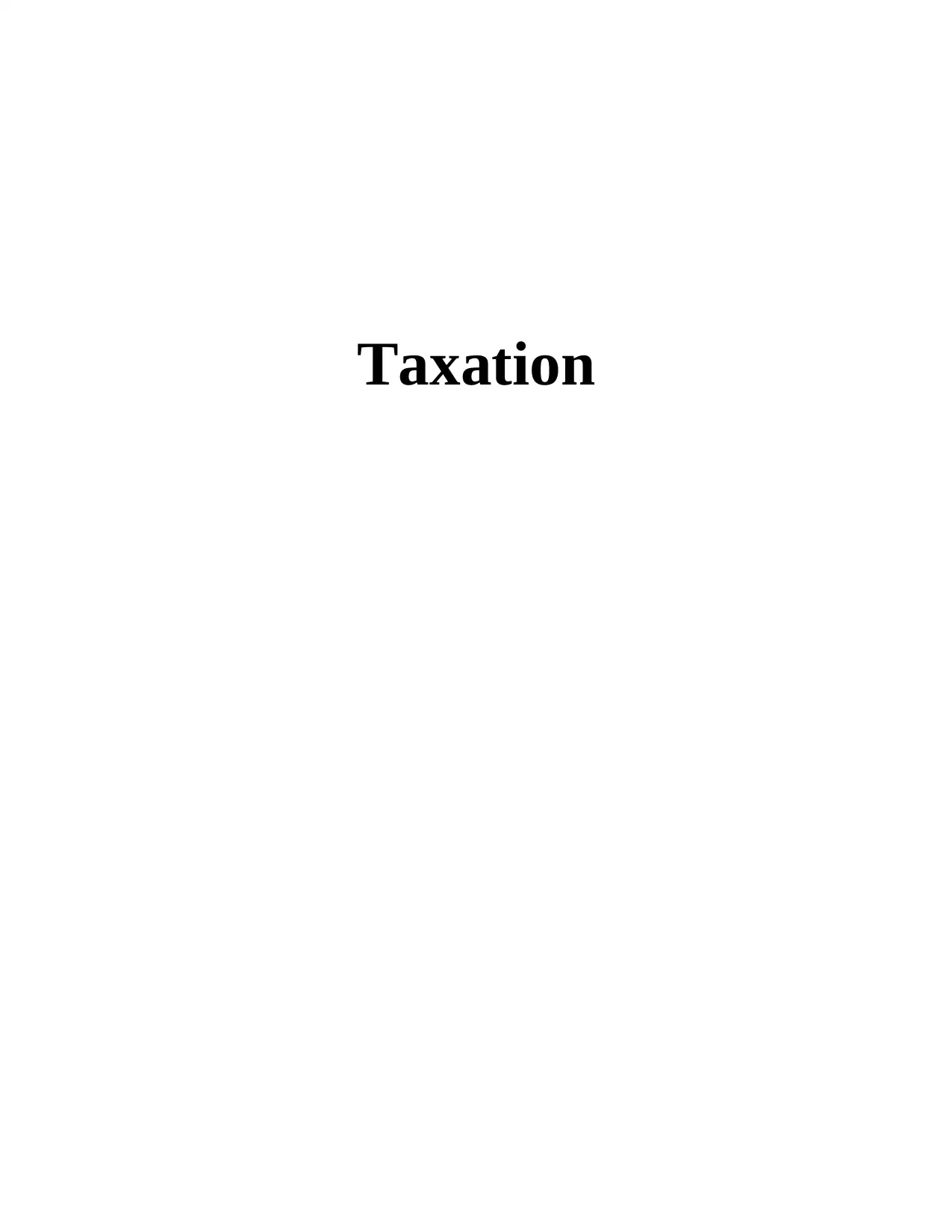
Taxation
Paraphrase This Document
Need a fresh take? Get an instant paraphrase of this document with our AI Paraphraser
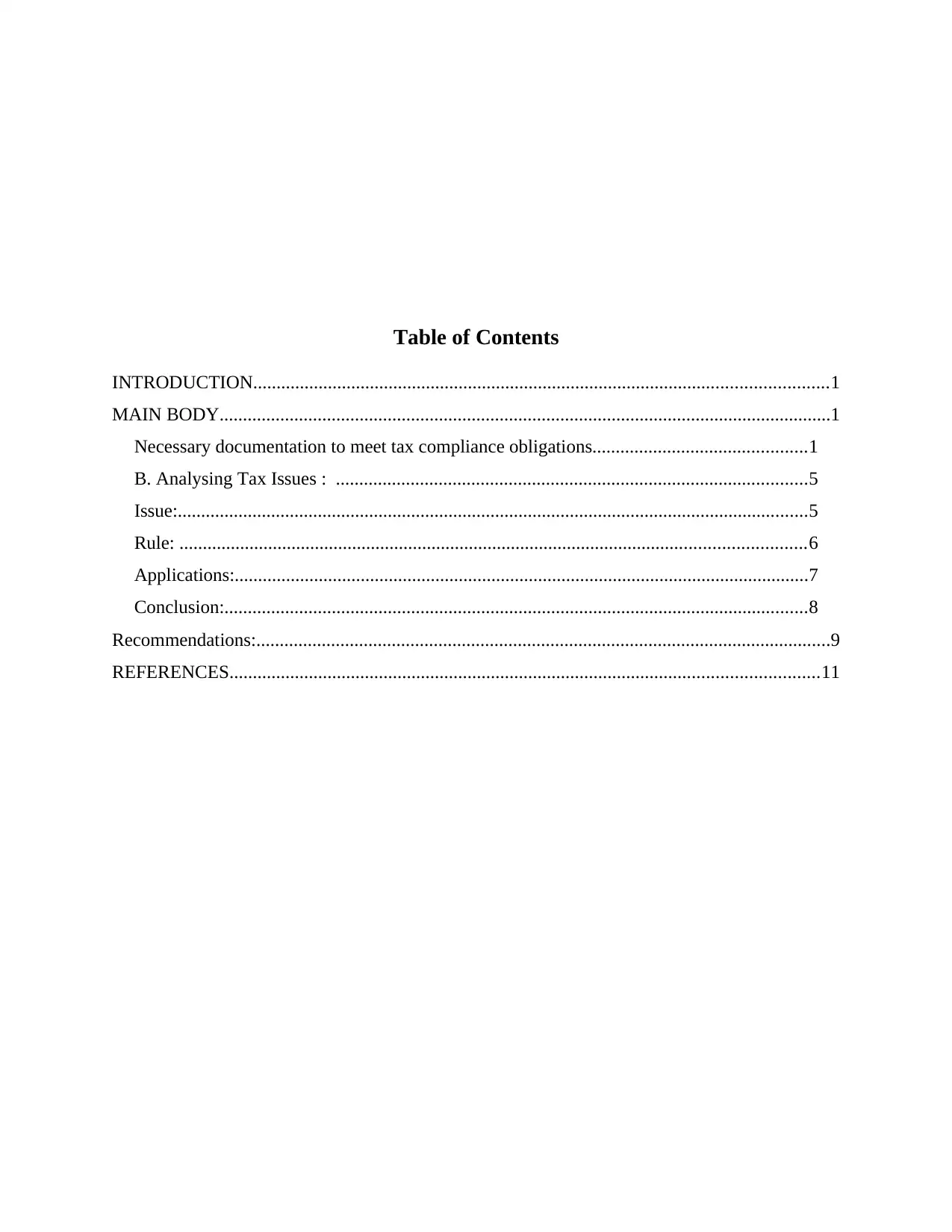
Table of Contents
INTRODUCTION...........................................................................................................................1
MAIN BODY...................................................................................................................................1
Necessary documentation to meet tax compliance obligations..............................................1
B. Analysing Tax Issues : .....................................................................................................5
Issue:.......................................................................................................................................5
Rule: ......................................................................................................................................6
Applications:...........................................................................................................................7
Conclusion:.............................................................................................................................8
Recommendations:...........................................................................................................................9
REFERENCES..............................................................................................................................11
INTRODUCTION...........................................................................................................................1
MAIN BODY...................................................................................................................................1
Necessary documentation to meet tax compliance obligations..............................................1
B. Analysing Tax Issues : .....................................................................................................5
Issue:.......................................................................................................................................5
Rule: ......................................................................................................................................6
Applications:...........................................................................................................................7
Conclusion:.............................................................................................................................8
Recommendations:...........................................................................................................................9
REFERENCES..............................................................................................................................11
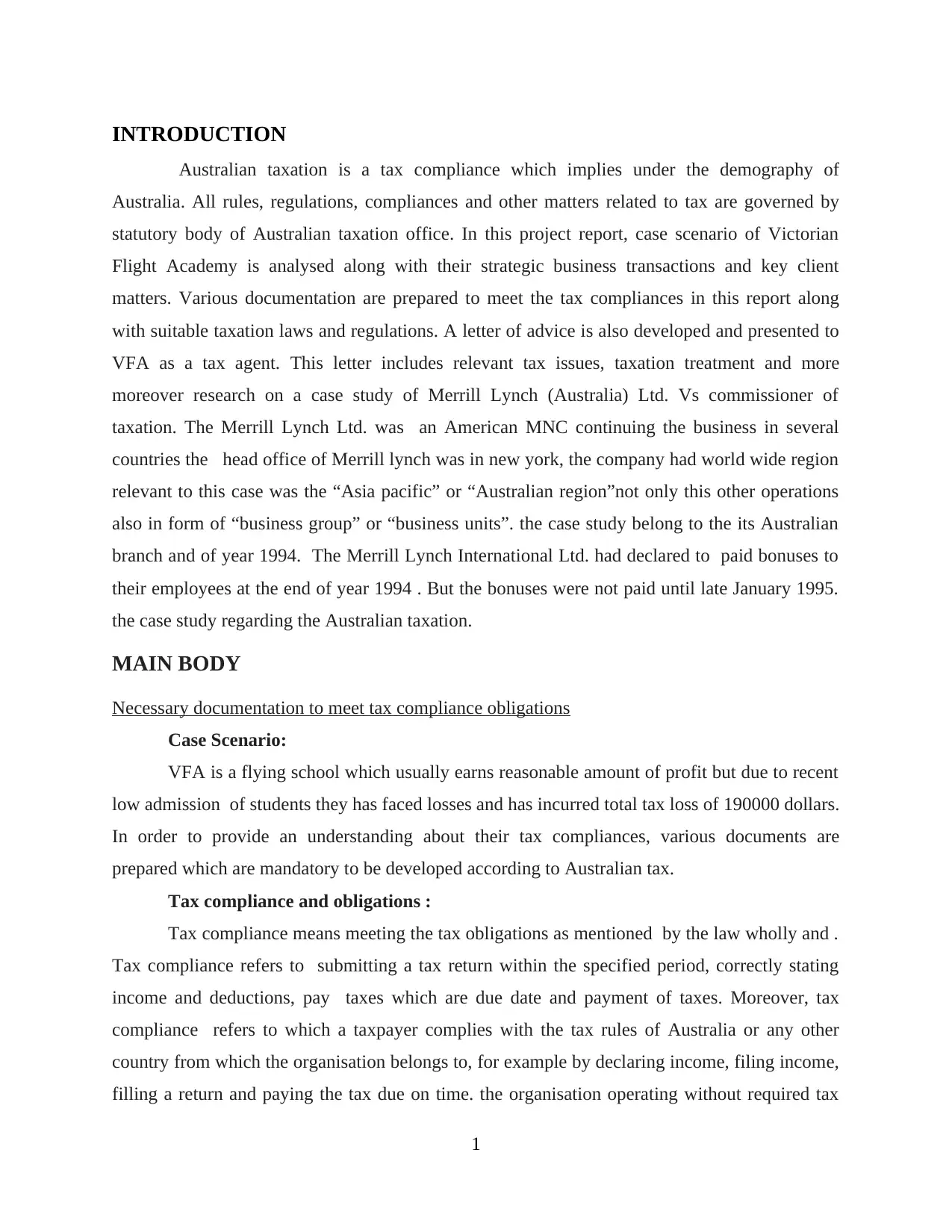
INTRODUCTION
Australian taxation is a tax compliance which implies under the demography of
Australia. All rules, regulations, compliances and other matters related to tax are governed by
statutory body of Australian taxation office. In this project report, case scenario of Victorian
Flight Academy is analysed along with their strategic business transactions and key client
matters. Various documentation are prepared to meet the tax compliances in this report along
with suitable taxation laws and regulations. A letter of advice is also developed and presented to
VFA as a tax agent. This letter includes relevant tax issues, taxation treatment and more
moreover research on a case study of Merrill Lynch (Australia) Ltd. Vs commissioner of
taxation. The Merrill Lynch Ltd. was an American MNC continuing the business in several
countries the head office of Merrill lynch was in new york, the company had world wide region
relevant to this case was the “Asia pacific” or “Australian region”not only this other operations
also in form of “business group” or “business units”. the case study belong to the its Australian
branch and of year 1994. The Merrill Lynch International Ltd. had declared to paid bonuses to
their employees at the end of year 1994 . But the bonuses were not paid until late January 1995.
the case study regarding the Australian taxation.
MAIN BODY
Necessary documentation to meet tax compliance obligations
Case Scenario:
VFA is a flying school which usually earns reasonable amount of profit but due to recent
low admission of students they has faced losses and has incurred total tax loss of 190000 dollars.
In order to provide an understanding about their tax compliances, various documents are
prepared which are mandatory to be developed according to Australian tax.
Tax compliance and obligations :
Tax compliance means meeting the tax obligations as mentioned by the law wholly and .
Tax compliance refers to submitting a tax return within the specified period, correctly stating
income and deductions, pay taxes which are due date and payment of taxes. Moreover, tax
compliance refers to which a taxpayer complies with the tax rules of Australia or any other
country from which the organisation belongs to, for example by declaring income, filing income,
filling a return and paying the tax due on time. the organisation operating without required tax
1
Australian taxation is a tax compliance which implies under the demography of
Australia. All rules, regulations, compliances and other matters related to tax are governed by
statutory body of Australian taxation office. In this project report, case scenario of Victorian
Flight Academy is analysed along with their strategic business transactions and key client
matters. Various documentation are prepared to meet the tax compliances in this report along
with suitable taxation laws and regulations. A letter of advice is also developed and presented to
VFA as a tax agent. This letter includes relevant tax issues, taxation treatment and more
moreover research on a case study of Merrill Lynch (Australia) Ltd. Vs commissioner of
taxation. The Merrill Lynch Ltd. was an American MNC continuing the business in several
countries the head office of Merrill lynch was in new york, the company had world wide region
relevant to this case was the “Asia pacific” or “Australian region”not only this other operations
also in form of “business group” or “business units”. the case study belong to the its Australian
branch and of year 1994. The Merrill Lynch International Ltd. had declared to paid bonuses to
their employees at the end of year 1994 . But the bonuses were not paid until late January 1995.
the case study regarding the Australian taxation.
MAIN BODY
Necessary documentation to meet tax compliance obligations
Case Scenario:
VFA is a flying school which usually earns reasonable amount of profit but due to recent
low admission of students they has faced losses and has incurred total tax loss of 190000 dollars.
In order to provide an understanding about their tax compliances, various documents are
prepared which are mandatory to be developed according to Australian tax.
Tax compliance and obligations :
Tax compliance means meeting the tax obligations as mentioned by the law wholly and .
Tax compliance refers to submitting a tax return within the specified period, correctly stating
income and deductions, pay taxes which are due date and payment of taxes. Moreover, tax
compliance refers to which a taxpayer complies with the tax rules of Australia or any other
country from which the organisation belongs to, for example by declaring income, filing income,
filling a return and paying the tax due on time. the organisation operating without required tax
1
⊘ This is a preview!⊘
Do you want full access?
Subscribe today to unlock all pages.

Trusted by 1+ million students worldwide
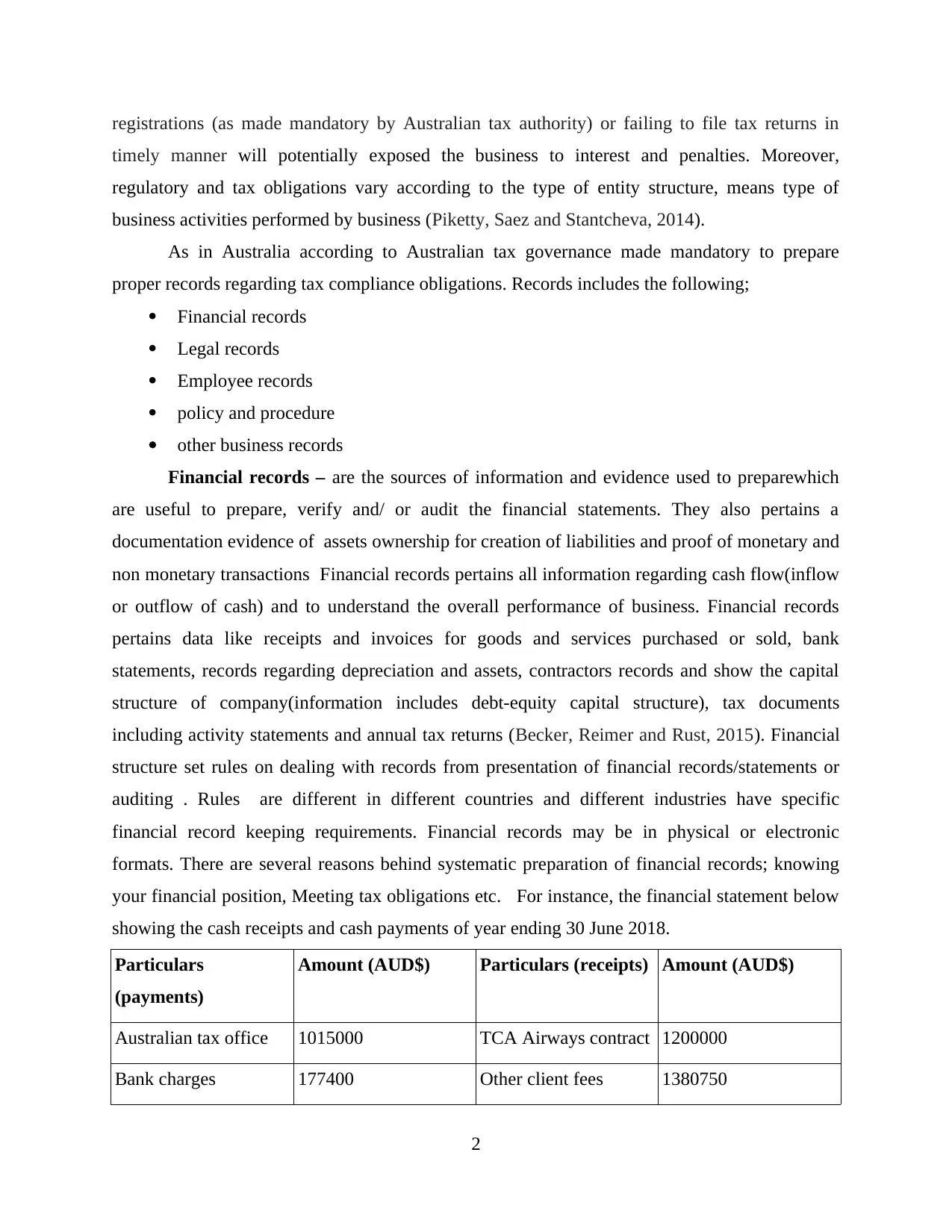
registrations (as made mandatory by Australian tax authority) or failing to file tax returns in
timely manner will potentially exposed the business to interest and penalties. Moreover,
regulatory and tax obligations vary according to the type of entity structure, means type of
business activities performed by business (Piketty, Saez and Stantcheva, 2014).
As in Australia according to Australian tax governance made mandatory to prepare
proper records regarding tax compliance obligations. Records includes the following;
Financial records
Legal records
Employee records
policy and procedure
other business records
Financial records – are the sources of information and evidence used to preparewhich
are useful to prepare, verify and/ or audit the financial statements. They also pertains a
documentation evidence of assets ownership for creation of liabilities and proof of monetary and
non monetary transactions Financial records pertains all information regarding cash flow(inflow
or outflow of cash) and to understand the overall performance of business. Financial records
pertains data like receipts and invoices for goods and services purchased or sold, bank
statements, records regarding depreciation and assets, contractors records and show the capital
structure of company(information includes debt-equity capital structure), tax documents
including activity statements and annual tax returns (Becker, Reimer and Rust, 2015). Financial
structure set rules on dealing with records from presentation of financial records/statements or
auditing . Rules are different in different countries and different industries have specific
financial record keeping requirements. Financial records may be in physical or electronic
formats. There are several reasons behind systematic preparation of financial records; knowing
your financial position, Meeting tax obligations etc. For instance, the financial statement below
showing the cash receipts and cash payments of year ending 30 June 2018.
Particulars
(payments)
Amount (AUD$) Particulars (receipts) Amount (AUD$)
Australian tax office 1015000 TCA Airways contract 1200000
Bank charges 177400 Other client fees 1380750
2
timely manner will potentially exposed the business to interest and penalties. Moreover,
regulatory and tax obligations vary according to the type of entity structure, means type of
business activities performed by business (Piketty, Saez and Stantcheva, 2014).
As in Australia according to Australian tax governance made mandatory to prepare
proper records regarding tax compliance obligations. Records includes the following;
Financial records
Legal records
Employee records
policy and procedure
other business records
Financial records – are the sources of information and evidence used to preparewhich
are useful to prepare, verify and/ or audit the financial statements. They also pertains a
documentation evidence of assets ownership for creation of liabilities and proof of monetary and
non monetary transactions Financial records pertains all information regarding cash flow(inflow
or outflow of cash) and to understand the overall performance of business. Financial records
pertains data like receipts and invoices for goods and services purchased or sold, bank
statements, records regarding depreciation and assets, contractors records and show the capital
structure of company(information includes debt-equity capital structure), tax documents
including activity statements and annual tax returns (Becker, Reimer and Rust, 2015). Financial
structure set rules on dealing with records from presentation of financial records/statements or
auditing . Rules are different in different countries and different industries have specific
financial record keeping requirements. Financial records may be in physical or electronic
formats. There are several reasons behind systematic preparation of financial records; knowing
your financial position, Meeting tax obligations etc. For instance, the financial statement below
showing the cash receipts and cash payments of year ending 30 June 2018.
Particulars
(payments)
Amount (AUD$) Particulars (receipts) Amount (AUD$)
Australian tax office 1015000 TCA Airways contract 1200000
Bank charges 177400 Other client fees 1380750
2
Paraphrase This Document
Need a fresh take? Get an instant paraphrase of this document with our AI Paraphraser
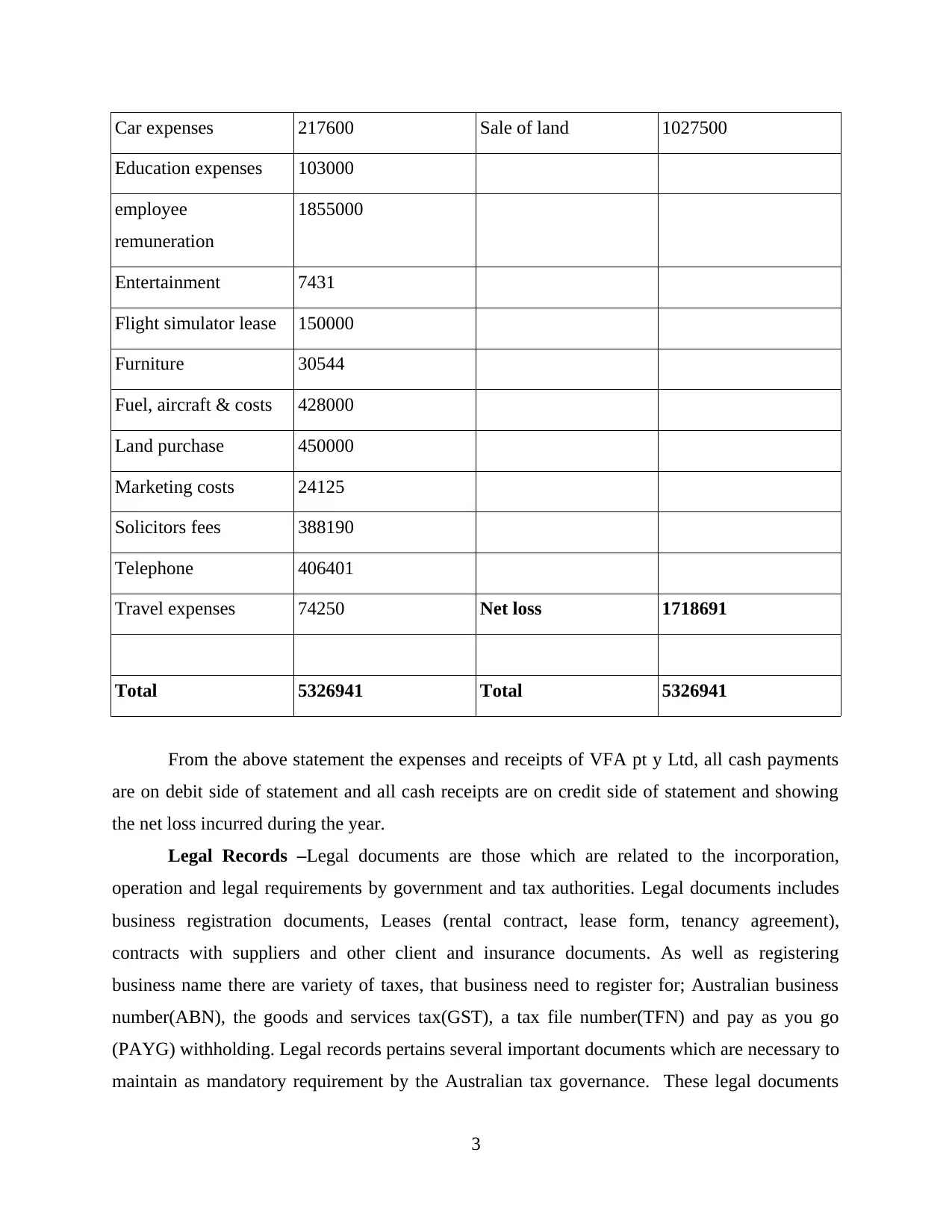
Car expenses 217600 Sale of land 1027500
Education expenses 103000
employee
remuneration
1855000
Entertainment 7431
Flight simulator lease 150000
Furniture 30544
Fuel, aircraft & costs 428000
Land purchase 450000
Marketing costs 24125
Solicitors fees 388190
Telephone 406401
Travel expenses 74250 Net loss 1718691
Total 5326941 Total 5326941
From the above statement the expenses and receipts of VFA pt y Ltd, all cash payments
are on debit side of statement and all cash receipts are on credit side of statement and showing
the net loss incurred during the year.
Legal Records –Legal documents are those which are related to the incorporation,
operation and legal requirements by government and tax authorities. Legal documents includes
business registration documents, Leases (rental contract, lease form, tenancy agreement),
contracts with suppliers and other client and insurance documents. As well as registering
business name there are variety of taxes, that business need to register for; Australian business
number(ABN), the goods and services tax(GST), a tax file number(TFN) and pay as you go
(PAYG) withholding. Legal records pertains several important documents which are necessary to
maintain as mandatory requirement by the Australian tax governance. These legal documents
3
Education expenses 103000
employee
remuneration
1855000
Entertainment 7431
Flight simulator lease 150000
Furniture 30544
Fuel, aircraft & costs 428000
Land purchase 450000
Marketing costs 24125
Solicitors fees 388190
Telephone 406401
Travel expenses 74250 Net loss 1718691
Total 5326941 Total 5326941
From the above statement the expenses and receipts of VFA pt y Ltd, all cash payments
are on debit side of statement and all cash receipts are on credit side of statement and showing
the net loss incurred during the year.
Legal Records –Legal documents are those which are related to the incorporation,
operation and legal requirements by government and tax authorities. Legal documents includes
business registration documents, Leases (rental contract, lease form, tenancy agreement),
contracts with suppliers and other client and insurance documents. As well as registering
business name there are variety of taxes, that business need to register for; Australian business
number(ABN), the goods and services tax(GST), a tax file number(TFN) and pay as you go
(PAYG) withholding. Legal records pertains several important documents which are necessary to
maintain as mandatory requirement by the Australian tax governance. These legal documents
3
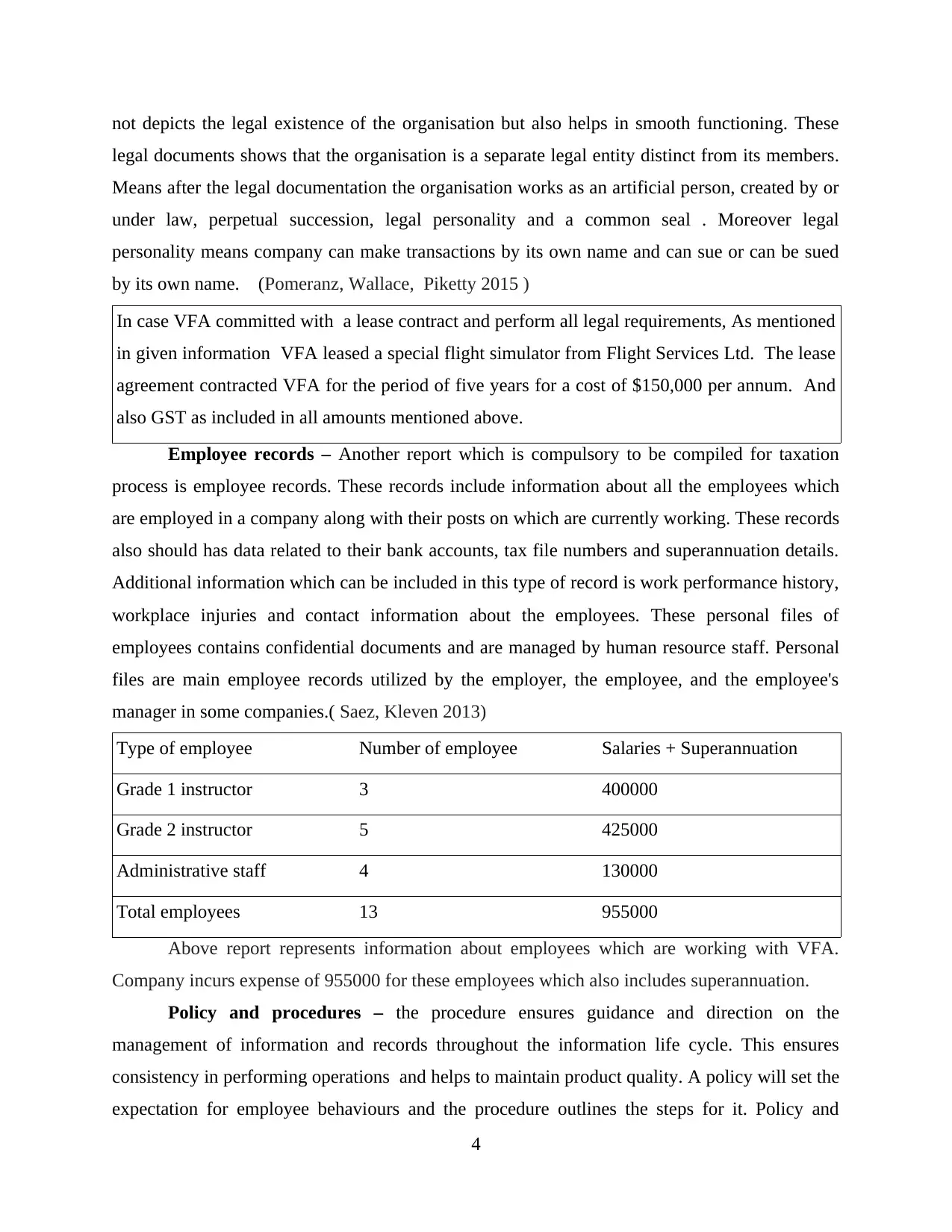
not depicts the legal existence of the organisation but also helps in smooth functioning. These
legal documents shows that the organisation is a separate legal entity distinct from its members.
Means after the legal documentation the organisation works as an artificial person, created by or
under law, perpetual succession, legal personality and a common seal . Moreover legal
personality means company can make transactions by its own name and can sue or can be sued
by its own name. (Pomeranz, Wallace, Piketty 2015 )
In case VFA committed with a lease contract and perform all legal requirements, As mentioned
in given information VFA leased a special flight simulator from Flight Services Ltd. The lease
agreement contracted VFA for the period of five years for a cost of $150,000 per annum. And
also GST as included in all amounts mentioned above.
Employee records – Another report which is compulsory to be compiled for taxation
process is employee records. These records include information about all the employees which
are employed in a company along with their posts on which are currently working. These records
also should has data related to their bank accounts, tax file numbers and superannuation details.
Additional information which can be included in this type of record is work performance history,
workplace injuries and contact information about the employees. These personal files of
employees contains confidential documents and are managed by human resource staff. Personal
files are main employee records utilized by the employer, the employee, and the employee's
manager in some companies.( Saez, Kleven 2013)
Type of employee Number of employee Salaries + Superannuation
Grade 1 instructor 3 400000
Grade 2 instructor 5 425000
Administrative staff 4 130000
Total employees 13 955000
Above report represents information about employees which are working with VFA.
Company incurs expense of 955000 for these employees which also includes superannuation.
Policy and procedures – the procedure ensures guidance and direction on the
management of information and records throughout the information life cycle. This ensures
consistency in performing operations and helps to maintain product quality. A policy will set the
expectation for employee behaviours and the procedure outlines the steps for it. Policy and
4
legal documents shows that the organisation is a separate legal entity distinct from its members.
Means after the legal documentation the organisation works as an artificial person, created by or
under law, perpetual succession, legal personality and a common seal . Moreover legal
personality means company can make transactions by its own name and can sue or can be sued
by its own name. (Pomeranz, Wallace, Piketty 2015 )
In case VFA committed with a lease contract and perform all legal requirements, As mentioned
in given information VFA leased a special flight simulator from Flight Services Ltd. The lease
agreement contracted VFA for the period of five years for a cost of $150,000 per annum. And
also GST as included in all amounts mentioned above.
Employee records – Another report which is compulsory to be compiled for taxation
process is employee records. These records include information about all the employees which
are employed in a company along with their posts on which are currently working. These records
also should has data related to their bank accounts, tax file numbers and superannuation details.
Additional information which can be included in this type of record is work performance history,
workplace injuries and contact information about the employees. These personal files of
employees contains confidential documents and are managed by human resource staff. Personal
files are main employee records utilized by the employer, the employee, and the employee's
manager in some companies.( Saez, Kleven 2013)
Type of employee Number of employee Salaries + Superannuation
Grade 1 instructor 3 400000
Grade 2 instructor 5 425000
Administrative staff 4 130000
Total employees 13 955000
Above report represents information about employees which are working with VFA.
Company incurs expense of 955000 for these employees which also includes superannuation.
Policy and procedures – the procedure ensures guidance and direction on the
management of information and records throughout the information life cycle. This ensures
consistency in performing operations and helps to maintain product quality. A policy will set the
expectation for employee behaviours and the procedure outlines the steps for it. Policy and
4
⊘ This is a preview!⊘
Do you want full access?
Subscribe today to unlock all pages.

Trusted by 1+ million students worldwide
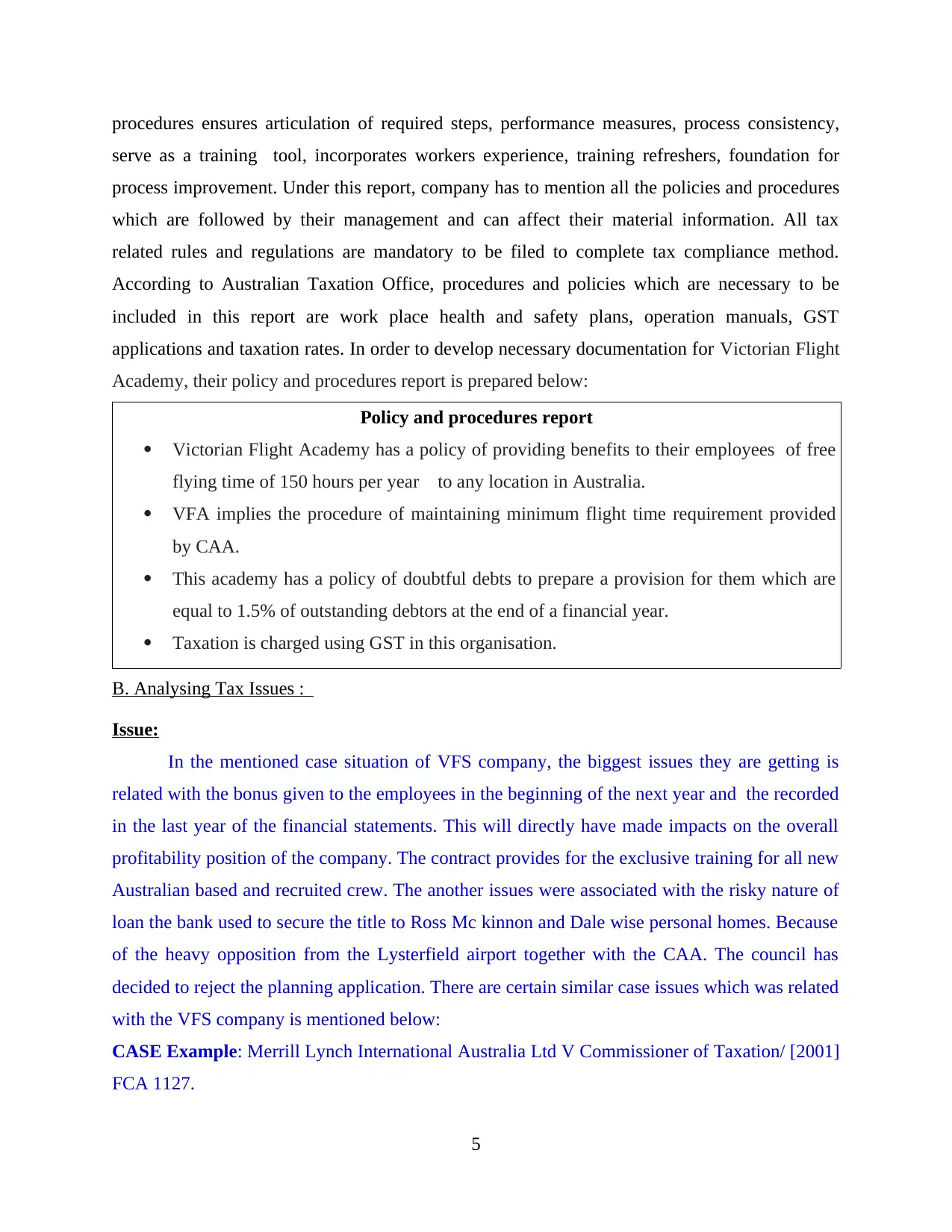
procedures ensures articulation of required steps, performance measures, process consistency,
serve as a training tool, incorporates workers experience, training refreshers, foundation for
process improvement. Under this report, company has to mention all the policies and procedures
which are followed by their management and can affect their material information. All tax
related rules and regulations are mandatory to be filed to complete tax compliance method.
According to Australian Taxation Office, procedures and policies which are necessary to be
included in this report are work place health and safety plans, operation manuals, GST
applications and taxation rates. In order to develop necessary documentation for Victorian Flight
Academy, their policy and procedures report is prepared below:
Policy and procedures report
Victorian Flight Academy has a policy of providing benefits to their employees of free
flying time of 150 hours per year to any location in Australia.
VFA implies the procedure of maintaining minimum flight time requirement provided
by CAA.
This academy has a policy of doubtful debts to prepare a provision for them which are
equal to 1.5% of outstanding debtors at the end of a financial year.
Taxation is charged using GST in this organisation.
B. Analysing Tax Issues :
Issue:
In the mentioned case situation of VFS company, the biggest issues they are getting is
related with the bonus given to the employees in the beginning of the next year and the recorded
in the last year of the financial statements. This will directly have made impacts on the overall
profitability position of the company. The contract provides for the exclusive training for all new
Australian based and recruited crew. The another issues were associated with the risky nature of
loan the bank used to secure the title to Ross Mc kinnon and Dale wise personal homes. Because
of the heavy opposition from the Lysterfield airport together with the CAA. The council has
decided to reject the planning application. There are certain similar case issues which was related
with the VFS company is mentioned below:
CASE Example: Merrill Lynch International Australia Ltd V Commissioner of Taxation/ [2001]
FCA 1127.
5
serve as a training tool, incorporates workers experience, training refreshers, foundation for
process improvement. Under this report, company has to mention all the policies and procedures
which are followed by their management and can affect their material information. All tax
related rules and regulations are mandatory to be filed to complete tax compliance method.
According to Australian Taxation Office, procedures and policies which are necessary to be
included in this report are work place health and safety plans, operation manuals, GST
applications and taxation rates. In order to develop necessary documentation for Victorian Flight
Academy, their policy and procedures report is prepared below:
Policy and procedures report
Victorian Flight Academy has a policy of providing benefits to their employees of free
flying time of 150 hours per year to any location in Australia.
VFA implies the procedure of maintaining minimum flight time requirement provided
by CAA.
This academy has a policy of doubtful debts to prepare a provision for them which are
equal to 1.5% of outstanding debtors at the end of a financial year.
Taxation is charged using GST in this organisation.
B. Analysing Tax Issues :
Issue:
In the mentioned case situation of VFS company, the biggest issues they are getting is
related with the bonus given to the employees in the beginning of the next year and the recorded
in the last year of the financial statements. This will directly have made impacts on the overall
profitability position of the company. The contract provides for the exclusive training for all new
Australian based and recruited crew. The another issues were associated with the risky nature of
loan the bank used to secure the title to Ross Mc kinnon and Dale wise personal homes. Because
of the heavy opposition from the Lysterfield airport together with the CAA. The council has
decided to reject the planning application. There are certain similar case issues which was related
with the VFS company is mentioned below:
CASE Example: Merrill Lynch International Australia Ltd V Commissioner of Taxation/ [2001]
FCA 1127.
5
Paraphrase This Document
Need a fresh take? Get an instant paraphrase of this document with our AI Paraphraser
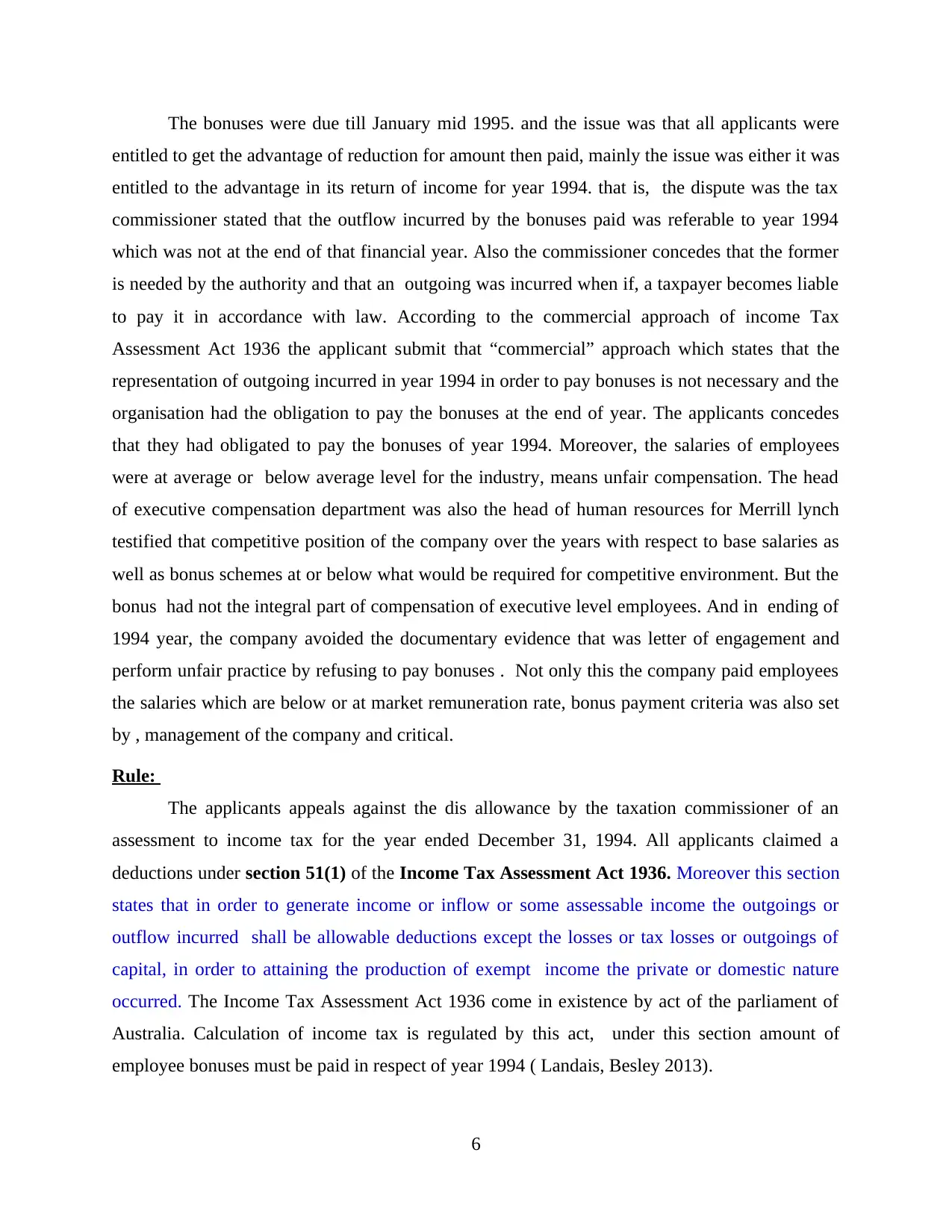
The bonuses were due till January mid 1995. and the issue was that all applicants were
entitled to get the advantage of reduction for amount then paid, mainly the issue was either it was
entitled to the advantage in its return of income for year 1994. that is, the dispute was the tax
commissioner stated that the outflow incurred by the bonuses paid was referable to year 1994
which was not at the end of that financial year. Also the commissioner concedes that the former
is needed by the authority and that an outgoing was incurred when if, a taxpayer becomes liable
to pay it in accordance with law. According to the commercial approach of income Tax
Assessment Act 1936 the applicant submit that “commercial” approach which states that the
representation of outgoing incurred in year 1994 in order to pay bonuses is not necessary and the
organisation had the obligation to pay the bonuses at the end of year. The applicants concedes
that they had obligated to pay the bonuses of year 1994. Moreover, the salaries of employees
were at average or below average level for the industry, means unfair compensation. The head
of executive compensation department was also the head of human resources for Merrill lynch
testified that competitive position of the company over the years with respect to base salaries as
well as bonus schemes at or below what would be required for competitive environment. But the
bonus had not the integral part of compensation of executive level employees. And in ending of
1994 year, the company avoided the documentary evidence that was letter of engagement and
perform unfair practice by refusing to pay bonuses . Not only this the company paid employees
the salaries which are below or at market remuneration rate, bonus payment criteria was also set
by , management of the company and critical.
Rule:
The applicants appeals against the dis allowance by the taxation commissioner of an
assessment to income tax for the year ended December 31, 1994. All applicants claimed a
deductions under section 51(1) of the Income Tax Assessment Act 1936. Moreover this section
states that in order to generate income or inflow or some assessable income the outgoings or
outflow incurred shall be allowable deductions except the losses or tax losses or outgoings of
capital, in order to attaining the production of exempt income the private or domestic nature
occurred. The Income Tax Assessment Act 1936 come in existence by act of the parliament of
Australia. Calculation of income tax is regulated by this act, under this section amount of
employee bonuses must be paid in respect of year 1994 ( Landais, Besley 2013).
6
entitled to get the advantage of reduction for amount then paid, mainly the issue was either it was
entitled to the advantage in its return of income for year 1994. that is, the dispute was the tax
commissioner stated that the outflow incurred by the bonuses paid was referable to year 1994
which was not at the end of that financial year. Also the commissioner concedes that the former
is needed by the authority and that an outgoing was incurred when if, a taxpayer becomes liable
to pay it in accordance with law. According to the commercial approach of income Tax
Assessment Act 1936 the applicant submit that “commercial” approach which states that the
representation of outgoing incurred in year 1994 in order to pay bonuses is not necessary and the
organisation had the obligation to pay the bonuses at the end of year. The applicants concedes
that they had obligated to pay the bonuses of year 1994. Moreover, the salaries of employees
were at average or below average level for the industry, means unfair compensation. The head
of executive compensation department was also the head of human resources for Merrill lynch
testified that competitive position of the company over the years with respect to base salaries as
well as bonus schemes at or below what would be required for competitive environment. But the
bonus had not the integral part of compensation of executive level employees. And in ending of
1994 year, the company avoided the documentary evidence that was letter of engagement and
perform unfair practice by refusing to pay bonuses . Not only this the company paid employees
the salaries which are below or at market remuneration rate, bonus payment criteria was also set
by , management of the company and critical.
Rule:
The applicants appeals against the dis allowance by the taxation commissioner of an
assessment to income tax for the year ended December 31, 1994. All applicants claimed a
deductions under section 51(1) of the Income Tax Assessment Act 1936. Moreover this section
states that in order to generate income or inflow or some assessable income the outgoings or
outflow incurred shall be allowable deductions except the losses or tax losses or outgoings of
capital, in order to attaining the production of exempt income the private or domestic nature
occurred. The Income Tax Assessment Act 1936 come in existence by act of the parliament of
Australia. Calculation of income tax is regulated by this act, under this section amount of
employee bonuses must be paid in respect of year 1994 ( Landais, Besley 2013).
6
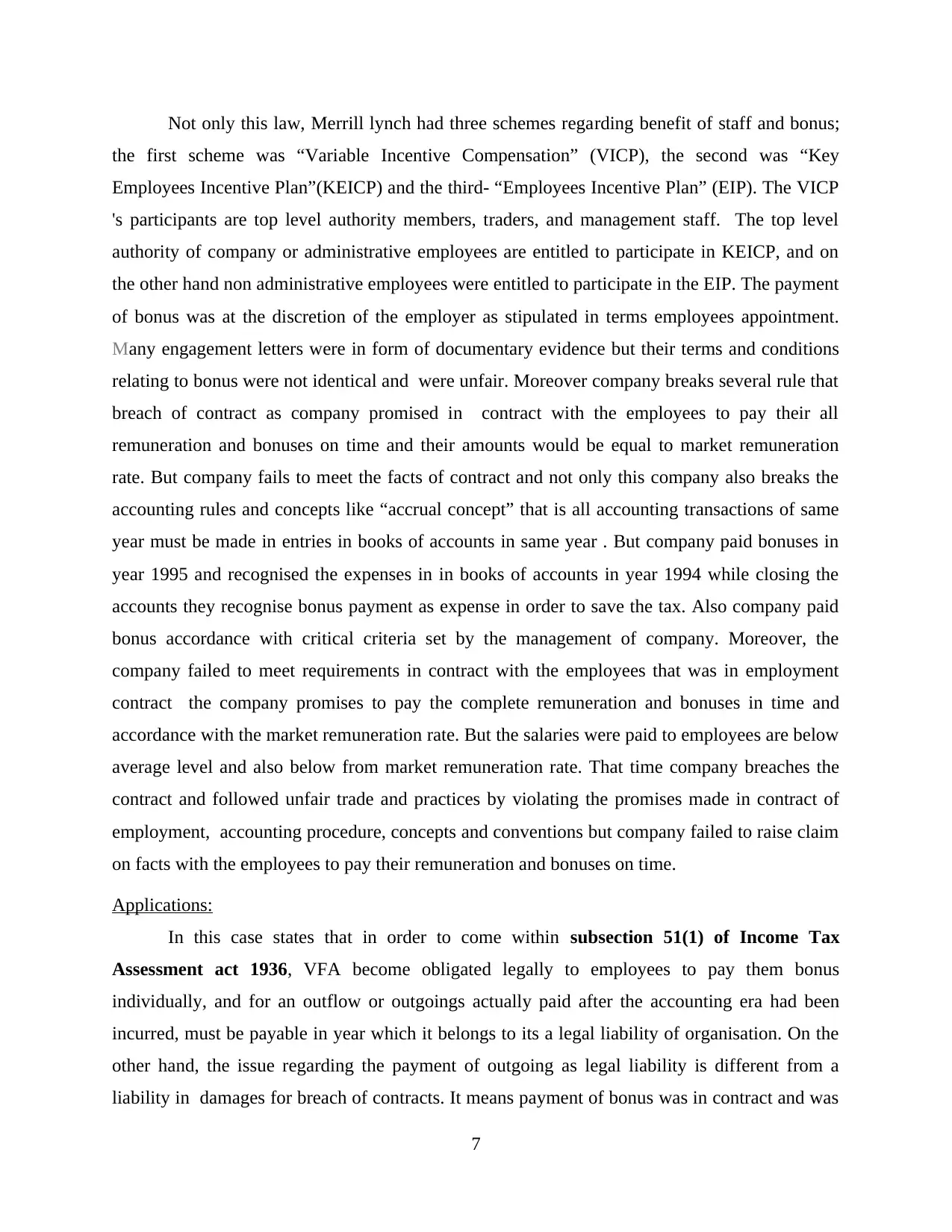
Not only this law, Merrill lynch had three schemes regarding benefit of staff and bonus;
the first scheme was “Variable Incentive Compensation” (VICP), the second was “Key
Employees Incentive Plan”(KEICP) and the third- “Employees Incentive Plan” (EIP). The VICP
's participants are top level authority members, traders, and management staff. The top level
authority of company or administrative employees are entitled to participate in KEICP, and on
the other hand non administrative employees were entitled to participate in the EIP. The payment
of bonus was at the discretion of the employer as stipulated in terms employees appointment.
Many engagement letters were in form of documentary evidence but their terms and conditions
relating to bonus were not identical and were unfair. Moreover company breaks several rule that
breach of contract as company promised in contract with the employees to pay their all
remuneration and bonuses on time and their amounts would be equal to market remuneration
rate. But company fails to meet the facts of contract and not only this company also breaks the
accounting rules and concepts like “accrual concept” that is all accounting transactions of same
year must be made in entries in books of accounts in same year . But company paid bonuses in
year 1995 and recognised the expenses in in books of accounts in year 1994 while closing the
accounts they recognise bonus payment as expense in order to save the tax. Also company paid
bonus accordance with critical criteria set by the management of company. Moreover, the
company failed to meet requirements in contract with the employees that was in employment
contract the company promises to pay the complete remuneration and bonuses in time and
accordance with the market remuneration rate. But the salaries were paid to employees are below
average level and also below from market remuneration rate. That time company breaches the
contract and followed unfair trade and practices by violating the promises made in contract of
employment, accounting procedure, concepts and conventions but company failed to raise claim
on facts with the employees to pay their remuneration and bonuses on time.
Applications:
In this case states that in order to come within subsection 51(1) of Income Tax
Assessment act 1936, VFA become obligated legally to employees to pay them bonus
individually, and for an outflow or outgoings actually paid after the accounting era had been
incurred, must be payable in year which it belongs to its a legal liability of organisation. On the
other hand, the issue regarding the payment of outgoing as legal liability is different from a
liability in damages for breach of contracts. It means payment of bonus was in contract and was
7
the first scheme was “Variable Incentive Compensation” (VICP), the second was “Key
Employees Incentive Plan”(KEICP) and the third- “Employees Incentive Plan” (EIP). The VICP
's participants are top level authority members, traders, and management staff. The top level
authority of company or administrative employees are entitled to participate in KEICP, and on
the other hand non administrative employees were entitled to participate in the EIP. The payment
of bonus was at the discretion of the employer as stipulated in terms employees appointment.
Many engagement letters were in form of documentary evidence but their terms and conditions
relating to bonus were not identical and were unfair. Moreover company breaks several rule that
breach of contract as company promised in contract with the employees to pay their all
remuneration and bonuses on time and their amounts would be equal to market remuneration
rate. But company fails to meet the facts of contract and not only this company also breaks the
accounting rules and concepts like “accrual concept” that is all accounting transactions of same
year must be made in entries in books of accounts in same year . But company paid bonuses in
year 1995 and recognised the expenses in in books of accounts in year 1994 while closing the
accounts they recognise bonus payment as expense in order to save the tax. Also company paid
bonus accordance with critical criteria set by the management of company. Moreover, the
company failed to meet requirements in contract with the employees that was in employment
contract the company promises to pay the complete remuneration and bonuses in time and
accordance with the market remuneration rate. But the salaries were paid to employees are below
average level and also below from market remuneration rate. That time company breaches the
contract and followed unfair trade and practices by violating the promises made in contract of
employment, accounting procedure, concepts and conventions but company failed to raise claim
on facts with the employees to pay their remuneration and bonuses on time.
Applications:
In this case states that in order to come within subsection 51(1) of Income Tax
Assessment act 1936, VFA become obligated legally to employees to pay them bonus
individually, and for an outflow or outgoings actually paid after the accounting era had been
incurred, must be payable in year which it belongs to its a legal liability of organisation. On the
other hand, the issue regarding the payment of outgoing as legal liability is different from a
liability in damages for breach of contracts. It means payment of bonus was in contract and was
7
⊘ This is a preview!⊘
Do you want full access?
Subscribe today to unlock all pages.

Trusted by 1+ million students worldwide

the contractual promise “to pay bonus” is differ from the contractual promise perform
contractual discretion honestly, in a fair manner and in good faith. The applicants must
completely accepted to pay the outgoings sought to be deducted in present case.
According to the financial performance of company VICP, KEICP and EIP and
allocation of global pool for VICP and EIP were determined or approved by the board of
directors. The non administrative employees were the participants of bonus scheme plan
EIP(Employees Incentive Plan). The amount which is required to be payable to employees by
VFA is calculated from return on equity plan. According to which calculation of bonus is done
on the basis of job performance of employee, number of working days or working hours. It was
calculated each year after that there was a process of accrual accounting throughout the year in
order to get EIP. But the salaries of employees were at or below average level and bonus would
be at or above what were the competitive standards. In early January 1995 updated lists of
eligible employees and proposed bonuses are paid to them according to set criteria and other
measures of performance appraisal performed by the human resource manager of company.
No doubt in this statement that circumstances of the employees varied. According to the
bonus payment criteria of company, some newly joined employees would not received the bonus
the company failed to attain claim on fact regarding the payment of bonus of employees in same
preceding years. Some employees received the salaries according to market remuneration rate
being paid to person of that level and on other hand others had received salaries amount which
was below then the market remuneration rate. But the aggregate shortfalls in amount of salaries
could not be treated as equal to the amount paid by company in late January 1995.
According to subsection 51(1) of Income Tax Assessment act 1936, the qualifying employees of
company were informed regarding hedged of currency. Qualifying employees were informed
earlier so that they plan for their financial affairs. The VFA falsely recognised the payment of
bonus amount as expenses in their books of accounts in order to save tax and the payment made
in next year.
Conclusion:
According to the overall assessment of the case examples of VFS to make
analysis of the financial statements effectively so that overall impact can be minimise properly.
As it has been found that there are issues regarding the bonus amount adjustments. The bonuses
were due till January mid 1995 and the issue was that all applicants were entitled to get the
8
contractual discretion honestly, in a fair manner and in good faith. The applicants must
completely accepted to pay the outgoings sought to be deducted in present case.
According to the financial performance of company VICP, KEICP and EIP and
allocation of global pool for VICP and EIP were determined or approved by the board of
directors. The non administrative employees were the participants of bonus scheme plan
EIP(Employees Incentive Plan). The amount which is required to be payable to employees by
VFA is calculated from return on equity plan. According to which calculation of bonus is done
on the basis of job performance of employee, number of working days or working hours. It was
calculated each year after that there was a process of accrual accounting throughout the year in
order to get EIP. But the salaries of employees were at or below average level and bonus would
be at or above what were the competitive standards. In early January 1995 updated lists of
eligible employees and proposed bonuses are paid to them according to set criteria and other
measures of performance appraisal performed by the human resource manager of company.
No doubt in this statement that circumstances of the employees varied. According to the
bonus payment criteria of company, some newly joined employees would not received the bonus
the company failed to attain claim on fact regarding the payment of bonus of employees in same
preceding years. Some employees received the salaries according to market remuneration rate
being paid to person of that level and on other hand others had received salaries amount which
was below then the market remuneration rate. But the aggregate shortfalls in amount of salaries
could not be treated as equal to the amount paid by company in late January 1995.
According to subsection 51(1) of Income Tax Assessment act 1936, the qualifying employees of
company were informed regarding hedged of currency. Qualifying employees were informed
earlier so that they plan for their financial affairs. The VFA falsely recognised the payment of
bonus amount as expenses in their books of accounts in order to save tax and the payment made
in next year.
Conclusion:
According to the overall assessment of the case examples of VFS to make
analysis of the financial statements effectively so that overall impact can be minimise properly.
As it has been found that there are issues regarding the bonus amount adjustments. The bonuses
were due till January mid 1995 and the issue was that all applicants were entitled to get the
8
Paraphrase This Document
Need a fresh take? Get an instant paraphrase of this document with our AI Paraphraser
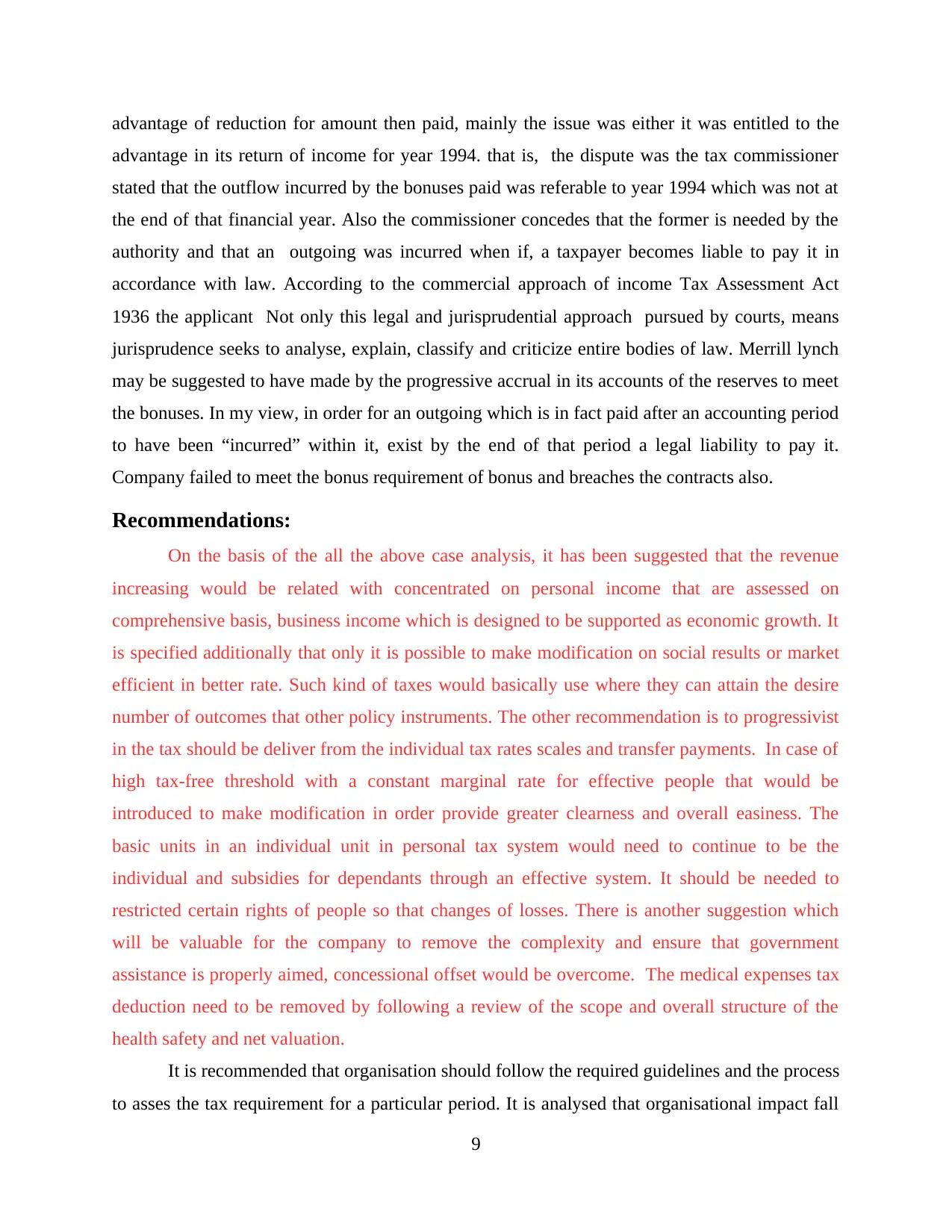
advantage of reduction for amount then paid, mainly the issue was either it was entitled to the
advantage in its return of income for year 1994. that is, the dispute was the tax commissioner
stated that the outflow incurred by the bonuses paid was referable to year 1994 which was not at
the end of that financial year. Also the commissioner concedes that the former is needed by the
authority and that an outgoing was incurred when if, a taxpayer becomes liable to pay it in
accordance with law. According to the commercial approach of income Tax Assessment Act
1936 the applicant Not only this legal and jurisprudential approach pursued by courts, means
jurisprudence seeks to analyse, explain, classify and criticize entire bodies of law. Merrill lynch
may be suggested to have made by the progressive accrual in its accounts of the reserves to meet
the bonuses. In my view, in order for an outgoing which is in fact paid after an accounting period
to have been “incurred” within it, exist by the end of that period a legal liability to pay it.
Company failed to meet the bonus requirement of bonus and breaches the contracts also.
Recommendations:
On the basis of the all the above case analysis, it has been suggested that the revenue
increasing would be related with concentrated on personal income that are assessed on
comprehensive basis, business income which is designed to be supported as economic growth. It
is specified additionally that only it is possible to make modification on social results or market
efficient in better rate. Such kind of taxes would basically use where they can attain the desire
number of outcomes that other policy instruments. The other recommendation is to progressivist
in the tax should be deliver from the individual tax rates scales and transfer payments. In case of
high tax-free threshold with a constant marginal rate for effective people that would be
introduced to make modification in order provide greater clearness and overall easiness. The
basic units in an individual unit in personal tax system would need to continue to be the
individual and subsidies for dependants through an effective system. It should be needed to
restricted certain rights of people so that changes of losses. There is another suggestion which
will be valuable for the company to remove the complexity and ensure that government
assistance is properly aimed, concessional offset would be overcome. The medical expenses tax
deduction need to be removed by following a review of the scope and overall structure of the
health safety and net valuation.
It is recommended that organisation should follow the required guidelines and the process
to asses the tax requirement for a particular period. It is analysed that organisational impact fall
9
advantage in its return of income for year 1994. that is, the dispute was the tax commissioner
stated that the outflow incurred by the bonuses paid was referable to year 1994 which was not at
the end of that financial year. Also the commissioner concedes that the former is needed by the
authority and that an outgoing was incurred when if, a taxpayer becomes liable to pay it in
accordance with law. According to the commercial approach of income Tax Assessment Act
1936 the applicant Not only this legal and jurisprudential approach pursued by courts, means
jurisprudence seeks to analyse, explain, classify and criticize entire bodies of law. Merrill lynch
may be suggested to have made by the progressive accrual in its accounts of the reserves to meet
the bonuses. In my view, in order for an outgoing which is in fact paid after an accounting period
to have been “incurred” within it, exist by the end of that period a legal liability to pay it.
Company failed to meet the bonus requirement of bonus and breaches the contracts also.
Recommendations:
On the basis of the all the above case analysis, it has been suggested that the revenue
increasing would be related with concentrated on personal income that are assessed on
comprehensive basis, business income which is designed to be supported as economic growth. It
is specified additionally that only it is possible to make modification on social results or market
efficient in better rate. Such kind of taxes would basically use where they can attain the desire
number of outcomes that other policy instruments. The other recommendation is to progressivist
in the tax should be deliver from the individual tax rates scales and transfer payments. In case of
high tax-free threshold with a constant marginal rate for effective people that would be
introduced to make modification in order provide greater clearness and overall easiness. The
basic units in an individual unit in personal tax system would need to continue to be the
individual and subsidies for dependants through an effective system. It should be needed to
restricted certain rights of people so that changes of losses. There is another suggestion which
will be valuable for the company to remove the complexity and ensure that government
assistance is properly aimed, concessional offset would be overcome. The medical expenses tax
deduction need to be removed by following a review of the scope and overall structure of the
health safety and net valuation.
It is recommended that organisation should follow the required guidelines and the process
to asses the tax requirement for a particular period. It is analysed that organisational impact fall
9
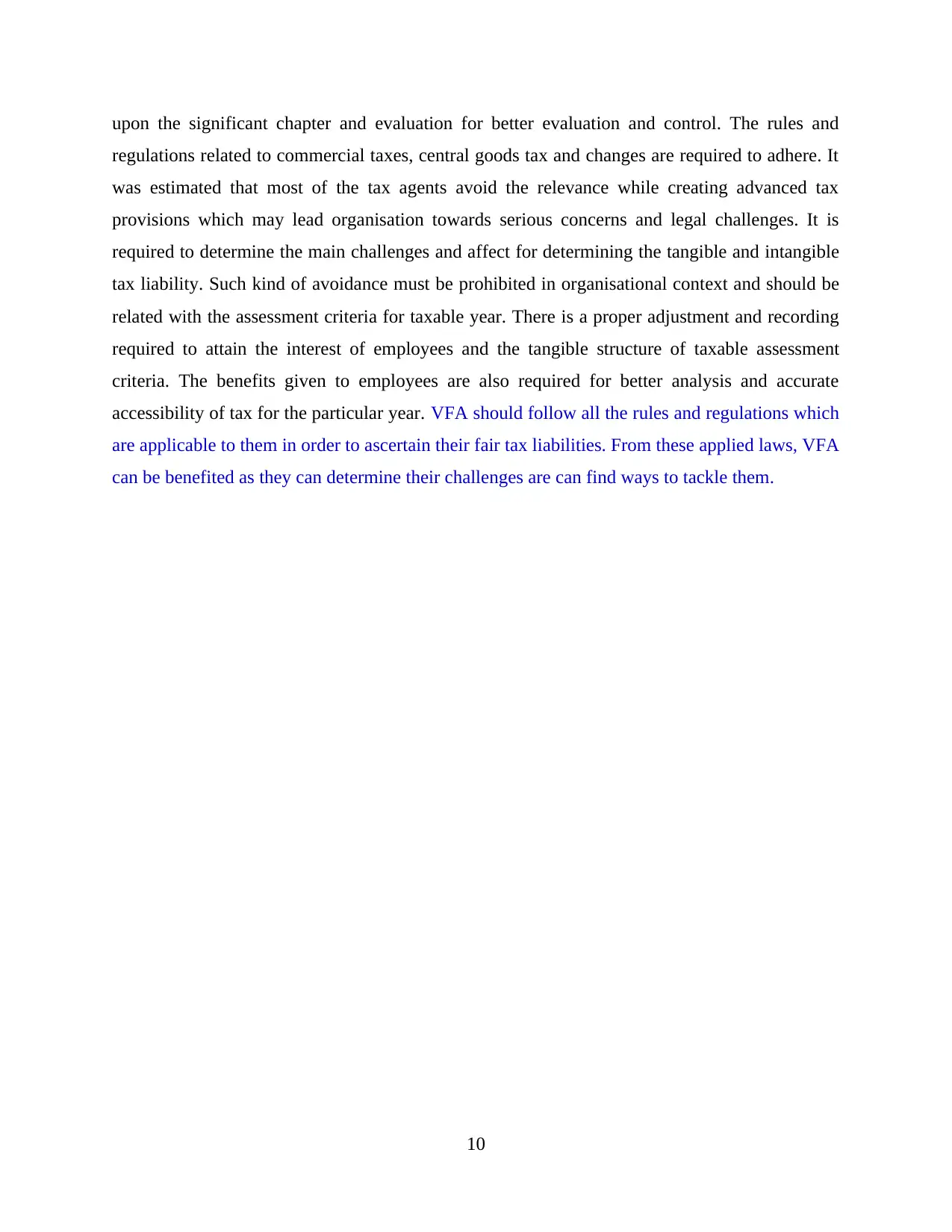
upon the significant chapter and evaluation for better evaluation and control. The rules and
regulations related to commercial taxes, central goods tax and changes are required to adhere. It
was estimated that most of the tax agents avoid the relevance while creating advanced tax
provisions which may lead organisation towards serious concerns and legal challenges. It is
required to determine the main challenges and affect for determining the tangible and intangible
tax liability. Such kind of avoidance must be prohibited in organisational context and should be
related with the assessment criteria for taxable year. There is a proper adjustment and recording
required to attain the interest of employees and the tangible structure of taxable assessment
criteria. The benefits given to employees are also required for better analysis and accurate
accessibility of tax for the particular year. VFA should follow all the rules and regulations which
are applicable to them in order to ascertain their fair tax liabilities. From these applied laws, VFA
can be benefited as they can determine their challenges are can find ways to tackle them.
10
regulations related to commercial taxes, central goods tax and changes are required to adhere. It
was estimated that most of the tax agents avoid the relevance while creating advanced tax
provisions which may lead organisation towards serious concerns and legal challenges. It is
required to determine the main challenges and affect for determining the tangible and intangible
tax liability. Such kind of avoidance must be prohibited in organisational context and should be
related with the assessment criteria for taxable year. There is a proper adjustment and recording
required to attain the interest of employees and the tangible structure of taxable assessment
criteria. The benefits given to employees are also required for better analysis and accurate
accessibility of tax for the particular year. VFA should follow all the rules and regulations which
are applicable to them in order to ascertain their fair tax liabilities. From these applied laws, VFA
can be benefited as they can determine their challenges are can find ways to tackle them.
10
⊘ This is a preview!⊘
Do you want full access?
Subscribe today to unlock all pages.

Trusted by 1+ million students worldwide
1 out of 13
Related Documents
Your All-in-One AI-Powered Toolkit for Academic Success.
+13062052269
info@desklib.com
Available 24*7 on WhatsApp / Email
![[object Object]](/_next/static/media/star-bottom.7253800d.svg)
Unlock your academic potential
Copyright © 2020–2025 A2Z Services. All Rights Reserved. Developed and managed by ZUCOL.





